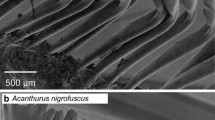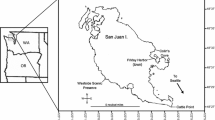Summary
Feeding choice of the echinoid Evechinus chloroticus was examined for six fucoid and one laminarian species of algae. Three experiments were conducted to determine the algal choice by echinoids under controlled conditions. In the first experiment, the seven algal species were presented to echinoids in laboratory conditions. The second experiment had replicates of the algal species placed randomly on a subtidal rocky reef where echinoids were abundant and randomly dispersed. For the third experiment, which was also field-based, replicates of one highly-ranked species, Ecklonia radiata, were presented to naturally dispersed Evechinus. In addition, a series of controlled observations was used to examine the order in which echinoids removed algae from mixed species stands on subtidal boulders and to determine if this was related to the experimentally demonstrated choices of algal species.
The results of the first two experiments showed that there were differences between algal species in the amount of material grazed by echinoids. Rankings of algal species from the field experiment were not correlated with rankings from the laboratory experiment. The order of removal of algal species from natural stands was correlated with the laboratory-based experimental rankings of algal species, but not with the rankings from the field-based experiment or with algal species availability. There were differences between algal species in their vulnerability to grazing by echinoids, as measured by regression analyses on the amount of material grazed from algal replicates vs. the number of attached echinoids. Within each species, echinoid numbers exerted a non-linear effect on the removal of algal material. In the third experiment, where only one species of algae was presented, the echinoids still distributed themselves non-randomly amongst replicates, aggregating on some samples.
Data on the finer scale distribution of algal species over the entire subtidal reef on which these experiments and observations were conducted indicate that Evechinus are not often presented with a choice of adult plants of several different species in natural stands.
The evidence from this study supports the conclusion that feeding preferences by echinoids are labile and do not clearly exert the major influence on the removal of plants from natural stands. Preference, as determined from experimental rankings of algal species, is only one of a number of factors which may affect the removal of algae by echinoids. Other important factors are the density of echinoids present, algal susceptibility to removal, and the distribution and abundances of the various algal species and echinoids relative to each other. It is suggested that algal life history characteristics may be unaffected by echinoids and that coevolutionary arguments are not appropriate for describing echinoid-algal interactions.
Similar content being viewed by others
References
Ayling AL (1978) The relation of food availability and food preferences to the field diet of an echinoid Evechinus chloroticus (Valenciennes). J exp Mar Biol Ecol 33:223–235
Ayling AM (1981) The role of biological disturbance in temperate subtidal encrusting communities. Ecology 62:830–847
Breen PA, Mann KH (1976a) Changing lobster abundance and the destruction of kelp beds by sea urchins. Mar Biol 34:137–142
Breen PA, Mann KH (1976b) Destructive grazing of kelp by sea urchins in eastern Canada. J. Fish Res Bd Canada 33:1278–1283
Cates RG, Orians GH (1975) Successional status and the palatability of plants to generalized herbivores. Ecology 56:410–418
Chapman ARO (1981) Stability of sea urchin dominated barren grounds following destructive grazing of kelp in St. Margaret's Bay, eastern Canada. Mar Biol 62:307–311
Choat JH, Schiel DR (In press) Patterns of distribution and abundance of large brown algae and invertebrate herbivores in subtidal regions of northern New Zealand. J exp Mar Biol Ecol
Dayton PK (1975a) Experimental studies of algal canopy interactions in a sea-otter dominated kelp community at Amchitka Island, Alaska. US Nat Mar Fish Serv Fish Bull 73:220–237
Dayton PK (1975b) Experimental evaluation of ecological dominance in a rocky intertidal algal community. Ecol Monogr 45:137–159
Dirzo R (1980) Experimental studies on slug-plant interactions. I. The acceptability of thirty plant species to the slug Agriolimax caruanae. J. Ecol 68:981–998
Dirzo R, Harper JL (1980) Experimental studies on slug-plant interactions. II. The effect of grazing by slugs on high density monocultures of Capsella bursa-pastoris and Poa annua. J. Ecol 68:999–1011
Dix TG (1969) Aggregating in the echinoid Evechinus chloroticus. Pac Sci 23:123–124
Dix TG (1970) Biology of Evechinus chloroticus (Echinoidea: Echinomatridae) from different localities. I. General. NZ J mar Freshwat Res 4:91–116
Duggins DO (1980) Kelp beds and sea otters: an experimental approach. Ecology 61:447–453
Duggins DO (1981) Interspecific facilitation in a guild of benthic marine herbivores. Oecologia (Berl) 48:157–163.
Ebert TA (1977) An experimental analysis of sea urchin dynamics and community interactions on a rock jetty. J. exp mar Biol Ecol 27:1–22
Emlen JM (1973) Ecology: an evolutionary approach, 493 pp. Reading Mass., Addison-Wesley
Estes JA, Smith NS, Palmisano JF (1978). Sea otter predation and community organisation in the western Aleutian Islands, Alaska. Ecology 59:822–833
Futuyma DJ (1976) Food plant specialization and environmental predictability in Lepidoptera. Am Nat 110: 285–292
Garnick E (1978) Behavioral ecology of Strongylocentrotus droebachiensis (Muller) (Echinodermata: Echinoidea). Aggregating behavior and chemotaxis. OEcologia 37:77–84
Gunnill FC (1980) Recruitment and standing stocks in populations of one green alga and five brown algae in the intertidal zone near La Jolla, California during 1973–1977. Mar Ecol Prog Ser 3:231–243
Himmelman JH, Steele DH (1971) Foods and predators of the green sea urchin Strongylocentrotus droebachiensis in Newfoundland waters. Mar Biol 9:315–322
Himmelman JH, Carefoot TH (1975) Seasonal changes in calorific value of three pacific coast seaweeds, and their significance to some marine invertebrate herbivores. J exp mar Biol Ecol 18:139–151
Janzen DH (1980) When is it coevolution?. Evolution 34:611–612
Jones GP, Thompson SM (1980) Social inhibition of maturation in females of the temperate wrasse Pseudolabrus celidotus and a comparison with the blennioid Tripterygion varium. Mar Biol 59:247–256
Jones NS, Kain JM (1967) Subtidal algal colonisation following the removal of Echinus. Helgol wiss Meeresunt 15:460–466
Kain JM (1979) A view of the genus Laminaria, Oceanogr. Mar Biol Ann. Rev 17:101–161
Landenberger DE (1968) Studies on selective feeding in the Pacific starfish, Pisaster, in southern California. Ecology 49:1062–1075
Lang C, Mann KH (1976) Changes in sea urchin populations after the destruction of kelp beds. Mar Biol 36:321–326
Larson BR, Vadas RL, Keser M (1980) Feeding and nutritional ecology of the sea urchin Strongylocentrotus drobachiensis in Maine, USA. Mar Biol 59:49–62
Lawrence JM (1975) On the relationship between marine plants and sea urchins. Oceanogr Mar Biol Ann. Rev 13:213–286
Leighton DL (1966) Studies of food preference in algivorous invertebrates of southern California kelp beds. Pac Sci 20:104–113
Leighton DL (1971) Grazing activities of benthic invertebrates in kelp beds. In, W.J. North (ed.), The biology of giant kelp beds (Macrocystis) in California. Nova Hedwigia 32:421–454
Leighton DL, Jones LG, North WJ (1966) Ecological relationships between giant kelp and sea urchins in southern California. In, Young, E.G., McLachlan, J.L. (eds.), Proc. Int. Seaweed Symp. 5, Halifax, 141–153. Pergamon Press
Leum LL, Choat JH (1980) Density and distribution patterns of the temperature marine fish Cheilodactylus spectabilis (Cheilodactylidae) in a reef environment. Mar Biol 57:327–337
Lubchenco J (1978) Plant species diversity in a marine intertidal community: Importance of herbivore food preference and algal competitive abilities. Am Nat 112:23–39
Maiorana VC (1978) What kinds of plants do herbivores really prefer? Am Nat 112:631–635
Mann KH (1972) Ecological energetics of the seaweed zone in a marine by on the Atlantic coast of Canada. I. Zonation and biomass of seaweeds. Mar Biol 12:1–10
Mann KH, Breen PA (1972) The relation between lobster abundance, sea urchins and kelp beds. J Fish Res. Bd Canada 29:603–609
Mattison JE, Trent JD, Shanks AL, Akin TB, Pearse JS (1977) Movement and feeding activity of red sea urchins (Strongylocentrotus franciscanus) adjacent to a kelp forest. Mar Biol 39:25–30
Menge BA (1972) Foraging strategy of a starfish in relation to actual prey availability and environmental predictability. Ecol Monogr 42:25–50
Moitoza DJ, Phillips DW (1979) Prey defense, predator preference and nonrandom diet: the interactions between Pycnopodia helianthoides and two species of sea urchins. Mar Biol 53:299–304
Nelson BV, Vance RR (1979) Diel foraging patterns of the sea urchin, Centrostephanus coronatus, as a predator avoidance strategy. Mar Biol 51:251–258
Nicotri ME (1980) Factors involved in herbivore food preference. J exp mar Biol Ecol 42:13–26
Otte D (1975) Plant preference and plant succession: a consideration of evolution of plant preference in Schistocerca. Oecologia 18:129–144
Paine RT (1966) Food web complexity and species diversity. Am Nat 100:65–75
Paine RT (1971) A short-term experimental investigation of resource partitioning in a New Zealand intertidal habitat. Ecology 52:1096–1106
Paine RT (1977) Controlled manipulations in the marine intertidal zone, and their contributions to ecological theory. Acad Nat Sci, spec. pub. 12:245–270
Paine RT, Vadas RL (1969 a) The effects of grazing by sea urchins, Strongylocentrotus spp., on benthic algal populations. Limnol Oceanogr 14:710–719
Paine RT, Vadas RL (1969 b) Calorific values of benthic algae and their postulated relation to invertebrate food preference. Mar Biol 4:79–86
Pearse JS, Hines JH (1979) Expansion of a central California kelp forest following the mass mortality of sea urchins. Mar Biol 31:83–91
Russo AR (1979) Dispersion and food differences between two populations of the sea urchin Strongylocentrotus franciscanus. J Biogeogr 6:407–414
Schiel DR (1981) A demographic and experimental evaluation of plant and herbivore interactions in subtidal algal stands. Ph D dissert. U of Auckland, 166 pp
Schiel DR, Choat JH (1980) Effects of density on monospecific stands of marine algae. Nature 285:324–326
Vadas RL (1977) Preferential feeding: an optimization strategy in sea urchins. Ecol Monogr 47:337–371
Vance RR (1979) Effects of grazing by the sea urchin, Centrostephanus coronatus, on prey community composition. Ecology 60:537–546
Vance RR, Schmitt RJ (1979) The effect of predator-avoidance behavior of the sea urchin, Centrostephanus coronatus, on the breadth of its diet. Oecologia (Berl) 44:21–25
Author information
Authors and Affiliations
Rights and permissions
About this article
Cite this article
Schiel, D.R. Selective feeding by the echinoid, Evechinus chloroticus, and the removal of plants from subtidal algal stands in Northern New Zealand. Oecologia 54, 379–388 (1982). https://doi.org/10.1007/BF00380007
Received:
Issue Date:
DOI: https://doi.org/10.1007/BF00380007




